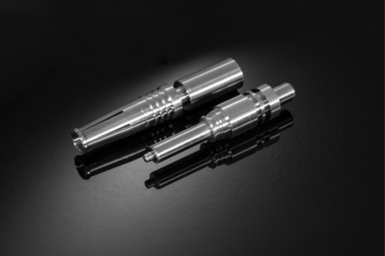Silver-graphite Coating Fulfills Technical Requirements
Graphite particles mixed into the silver layer of this coating promote great abrasion resistance at maximum loading performance.
Umicore MDS (Schwäbisch Gmünd, Germany) developed a silver-graphite dispersion electrolyte specifically designed for coating connector contacts in high-power applications. One application of this development is high-power charging (HPC). The electrodes coated with silver dispersion layers deposited with the electrolyte, Arguna C-100, are reported to be extremely stable, even at elevated temperatures, and enable maximum charging power the entire service life of the charging plugs.

Contact socket and contact pin for EV charging plug coated with the silver-graphite dispersion electrolyte Arguna C-100 from Umicore.
Photo Credit: Umicore MDS
Silver coatings deposited with Arguna C-100, the company says, meet the increased requirements of the industry in terms of reliability and durability for connector contacts.
Many manufacturers and suppliers were not satisfied with the longevity of previous connector contacts for transferring high charging power from the power source to the application or battery. Coatings with fine silver are beneficial in terms of electrical and thermal conductivity. The tendency to cold welding in conjunction with low hardness and a high coefficient of friction leads to rapid wear of the silver coatings when mated frequently. In order to achieve the required mating cycles and to minimize wear, additional contact lubricants are used on the silver surfaces. Due to the accumulation of dirt and dust particles, corrosive or abrasive foreign layers can form over time, which can lead to an increase in temperature and a reduction in charging performance.
Hard silver coatings (silver alloys) have a significantly higher hardness and show noticeably improved vibration resistance in some applications. However, added metals have a detrimental effect on electrical conductivity, and the coefficient of friction is usually close to the fine silver level.
The need for durable and high-performance silver coatings for such high-power applications is prevalent. Particularly in the field of electromobility,
a shortened service life of charging plugs can not only cause costs due to material, time and service expenditure — the image also suffers. If a permanently installed vehicle inlet of an electric car needs to be replaced at an early stage or if the charging performance of the charging infrastructure continuously decreases, the reliability and quality of the supplier is often called into question.
Arguna C-100 achieves its notable level of abrasion resistance through
embedded graphite particles in the silver layer. As a result, the desire from the industry for high reliability and durability of the contact coating and the charging plug is met, according to Umicore MDS. An optimized graphite component embedded in the silver matrix and acting as a solid lubricant makes this possible. With each friction process, a new surface is created and the abraded tips of the graphite lamellae are distributed over the friction surface. The usual abrasion of the silver surface is prevented, the contact resistances are kept small and thus a continuously high charging performance is ensured.
"Under laboratory conditions, an end-of-life tribometer test proves the
low and stable coefficient of friction of the Arguna C-100 coating system. Even after more than 50,000 mating cycles, a silver graphite layer can be intact and cross-compatibility with other mating contact materials like fine, hard or dispersion silver coatings, completes the required functionality in the field," explains Friedrich Talgner, head of technical applications.
Arguna C-100’s purpose is to combine and extend the positive properties of
fine and hard silver. It is designed to possess the electrical conductivity capabilities of the fine silver matrix while simultaneously increasing the abrasion resistance with the addition of the solid lubrication of the graphite, ultimately resulting in the reduction of wear.
Related Content
An Overview of Electroless Nickel Plating
By definition, electroless plating is metal deposition by a controlled chemical reaction.
Read MoreHow to Choose Between Sulfate and Chloride-Based Trivalent Chromium
There are several factors to consider when choosing between sulfate and chloride-based baths for trivalent chromium plating. Mark Schario of Columbia Chemical discusses the differences and what platers should keep in mind when evaluating options.
Read MoreA Chromium Plating Overview
An overview of decorative and hard chromium electroplating processes.
Read MoreSuccessful South African Plater Beating the Odds
Remaining focused on quality and reliability, Team Plating Works stays profitable in a volatile and challenging economy.
Read MoreRead Next
Episode 45: An Interview with Chandler Mancuso, MacDermid Envio Solutions
Chandler Mancuso, technical director with MacDermid Envio discusses updating your wastewater treatment system and implementing materials recycling solutions to increase efficiencies, control costs and reduce environmental impact.
Read MoreDelivering Increased Benefits to Greenhouse Films
Baystar's Borstar technology is helping customers deliver better, more reliable production methods to greenhouse agriculture.
Read MoreEducation Bringing Cleaning to Machining
Debuting new speakers and cleaning technology content during this half-day workshop co-located with IMTS 2024.
Read More













.jpg;maxWidth=300;quality=90)











